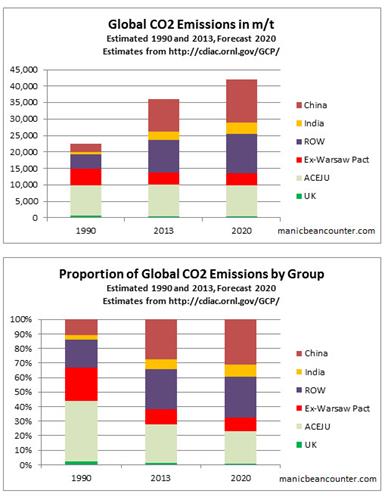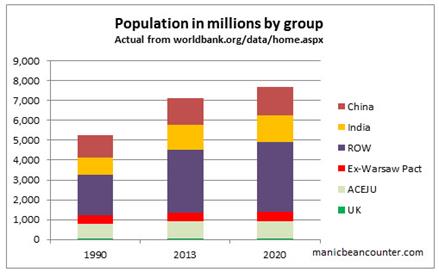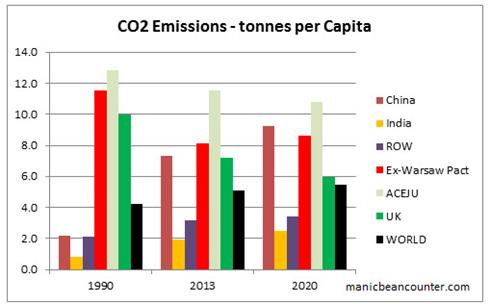Updated with more examples 14/12/13 11am
The Tyndall Centre for Climate Change Research (HQ at the University of East Anglia, with branch office just down road from me at Manchester University) held The Radical Emission Reduction Conference: 10-11 December 2013 at the offices of the Royal Society. Joanne Nova reporting on the conference quoted the following:-
Today, in 2013, we face an unavoidably radical future. We either continue with rising emissions and reap the radical repercussions of severe climate change, or we acknowledge that we have a choice and pursue radical emission reductions: No longer is there a non- radical option.
My first reaction was
These people have not discovered logic or the real world outside of their groups. For instance
1. Where are the robust, unambiguous, forecasts of “severe climate change” impacts? Lacking this, the “do-nothing” scenario could be an alternative.
2. Radical emission reduction policies may not work. Useless policies could end up causing mass impoverishment, leaving future generations much less able to cope with the coming climate apocalypse.
3. Radical emission reduction policies may be both necessary and work in theory, but will never be enacted because “radical” activists have not learnt the art of persuasion and appreciating that other points of view are possible.
Following an initial reading of the conference abstracts, this initial reaction was somewhat understated. The 1.01MB file is at radicalplanabstracts.pdf. Some notes.
The Philosopher’s case for Totalitarianism
On pages 15 to 17 is ‘Responsibility for radical change in emission of greenhouse gases’
Page 16
Generally it is acceptable to frame scenarios of climate change in terms of cost-efficiency, percentages of emission reduction or the target atmospheric CO2 concentration. Yet we develop the argument that predefining the outcome of any change limits the possible processes leading to this change. In fact, when we already know the necessary outcome, the change that is necessary cannot be considered radical at all.
Page 17
For the radical change in greenhouse gas emissions the responsibility towards the radicalness of change means that those involved in the climate change negotiations and policy-making need to let go of their preconceived notions of climate, change, and general structure of cause and effect, science and human life.
And in conclusion
We argue that one cannot desire radical change without acknowledging that we (individuals and institutions) may be swept off our feet, that we may lose influence and control. We need to accept that modifications are not going to bring about radical emission reductions. What we need is radical change, including radical change in our own backyard, our understanding of leadership and in our own epistemic notions of what change means.
All that matters is saving the planet. It is not about saving the planet for future generations, as we humans do not matter. It is not about the climate models being accurate – as they are supposed to about modelling cause (increasing greenhouse gas levels) with the effect (catastrophic anthropogenic global warming). And it is not science.
The Economist’s case for Totalitarianism
On pages 7 to 9 is ‘Demand-side regulation in the policy mix to achieve radical CO2 reductions: modelling global decarbonisation with E3MG‘
Page 7
Radical reductions in CO2 emissions from reductions in consumption of fossil fuels across the economy could be modelled as coming from changes in life-styles, regulations or prices or a mix of all three. The main demand-side sources arise from the use of fossil fuels in buildings, transport and industry, and indirectly, via the use of electricity generated from fossil fuels. We assume that the power sector becomes decarbonised via a mix of emission trading schemes and regulations. We then consider the implications of a rapid reduction in demand-side fossil-fuel use coming from higher energy prices and regulation of equipment standards and energy efficiency.
To achieve the plan, all the advanced countries (and some not-so-advanced like Belarus) will introduce emissions trading schemes ETS with low tariffs in 2015, sharply escalating after 2020. Emerging economies (e.g. China, Brazil & Mexico) will introduce schemes in 2020 at lower rates. By 2030, in conjunction with tougher economic regulations, coal-fired power stations will be phased out.
With respect to the regulations
These effects are then strengthened from 2020 onwards, with the energy saving, the associated investment and increase in prices all rising by some 17%pa. By 2030 the strength of the regulations is about 5 times that assumed by the IEA. The scale of this increase gives an indication of just how strong regulations have to become.
Italics mine. The plan will only work if it far, far tougher than anything yet on the table. At least the models predict that there will be a small net benefit.
The Increase in investment, including indirect effects, is about 4% above the reference scenario by 2030. Combined with the effects of revenue recycling and the lower growth in world oil prices, it generates more output and employment, raising both growth rates by some 0.2 percentage points each year over the decade.
So in China, which has had near 10% annual growth for over two decades based on cheap coal-based energy, can switch to much more expensive and less reliable “clean” energy sources, with a small net benefit. Hmmm.
People will change their lifestyles if they are unable to afford to do otherwise. Businesses who do not respond will be expropriated for the common good, and their denialist bosses sent to be re-educated in labour camps. The plan will work, and the economic models are infallible. Any deviation from the plan will be therefore be due to economic sabotage.
The Psychologist sees a problem – but does not want to say so
On pages 12 to 13 is ‘Psychology of human acceptance and engagement‘
A short abstract, quoted in full
The need to voluntarily write off fossil fuel reserves is now clear. The continuing exponential nature of CO2 emissions tells us that none of the talk and action to date on climate change has produced a detectable dent in the trajectory. It also strongly suggests that since efficiency and innovation have gone hand in hand with emissions growth, they are, in themselves, more likely to be integral to the dynamics of growth than to enable mitigation. The exponentiality further suggests that a feedback mechanism needs breaking at the global system level; there is plenty of evidence that local reductions are absorbed elsewhere in the system, like a squeezed balloon.
(Especially in the absence of very widespread CCS), a global constraint on the extraction of fuel is a ‘must have’. All actions can therefore be viewed in terms of their contribution to the conditions under which the global socio- economic system might shift to one in which humans have voluntarily agreed to leave fuel in the ground. Such conditions are more than the cocktail of science, politics, technology and economics to which most climate change analysis, including the above summary, is constrained. The most critically lacking element is the psychology of human acceptance of and engagement with a problem such as climate change, characterised by its abstraction, uncertainty and inescapably global systemic nature. We need to view this as an unsolved mystery, the most ignored part of the puzzle and critical to bridging the void between rationale analysis and policy.
My interpretation is that human beings do not want to sacrifice their immediate interests to some ill-defined and distant goals spoken by some “Johnny foreigners” who do not share their values. Further, leaders of energy-producing authoritarian countries will not leave these fossil fuels in the ground when they know that to do so would lead to economic collapse, swiftly followed by a violent overthrow of their regimes and their possible deaths.
The Social Scientist’s case for a Dictatorship
On pages 23 to 25 is ‘Social science prospects for radical change’
The only acknowledged truth is from the UNIPCC and the Stern Review. No acknowledgement that contrary perspectives are possible.
Social psychologists, among others, have drawn attention to the potential for climate mitigation which could be unlocked through the application of insights into the affective, cognitive, value-based, and social and broader contextual determinants of people’s actions.
Social Scientists must change the way we think.
Despite the acknowledged need to understand and influence the role of the individual in contributing to climate change, the disparity between what might be and what has been achieved has become discomfiting.
They are not getting the message across, and they cannot understand why.
With the exception of the establishment of a small number of iconic behaviours such as recycling, it has proved extremely difficult to bring about meaningful transformations in personal emissions at either the individual or societal level. On the basis of a number of reviews, it would seem that whilst some change is achievable, there are profound limits to what can be accomplished using current, conventional approaches.
Translation – we need more power.
Current methods of persuasion have failed. We need something different.
First up is control of the press, followed by enforced re-education have been the historical approaches.
There has been an expectation that change be confined to small-scale and undemanding changes in behaviour (for example, switching off unused appliances); a concomitant neglect of highly impactful activities because of the perceived political infeasibility of doing so (for example, levels of consumption);
Translation – we need more power.
… a reluctance on the part of social scientists to take strong normative positions (specifically, to see themselves as advocates for change rather than disinterested theoreticians);
Translation – we need stronger and more dogmatic beliefs in the cause.
…. and a lack of integration – and at times outright hostility – between different disciplinary traditions (for example between behavioural science and social practice based approaches).
Translation – we need only achieve this power if we unite into a unified force.
In the first instance, we suggest that a radical social science of climate change mitigation would set out deliberately to enter territory which is complex and often seemingly intractable – but where personal emissions are significant.
Basically ban the use of cars and forget about foreign holidays in aeroplanes. Persuade people to do without the elements of consumerist society, such as designer clothes, televisions, computers, washing machines, Christmas etc.
That these behavioural changes are nothing to do with combatting a global climate change problem is shown by a very telling omission. There is no mention of any country other than the UK.
Democracy and human rights may have to be suspended
On pages 25 to 26- ‘Is wartime mobilisation a suitable policy model for rapid national climate mitigation?‘
The abstract concludes
We find that, while wartime experience suggests some potential strategies for rapid climate mitigation in the areas of finance and labour, it also has severe limitations, resulting from its lack of democratic processes. Furthermore, since restructuring the existing socio-economic system to mitigate climate change is more complex than fighting a war and since the threat of climate change is less obvious to non-scientists, it is unlikely that the public will be unified in support of such executive action.
Again, nothing about the global economy, just the UK.
And opportunities exploited for a radical redistribution of emissions
On pages 27 to 29 is ‘Personal carbon trading in a radical future‘
Personal carbon trading (PCT) is a radical and innovative mitigation policy which offers an equitable means of reducing emissions from household energy use and personal travel. PCT offers two dimensions of fairness – firstly, everyone gets an equal carbon allowance, a ‘fair share’. Secondly, modelling of the impacts of a PCT scheme shows it would be progressive and would disadvantage fewer low-income people than an alternative policy of carbon taxation.
Everyone will be allocated an equal share, and the computer models show that it will work.
What is left out is the problem of rolling this out globally to solve a global problem.
As I always say, compare and contrast my interpretations with what is actually written. When a publicly-funded body brings together a number of academics from different disciplines, all calling for massively increased power, there is something amiss. When it is held within the UK’s “academy of sciences” building, it is being given an official veneer of respectability.
NB First time comments are moderated. The comments can be used as a point of contact.
Kevin Marshall








